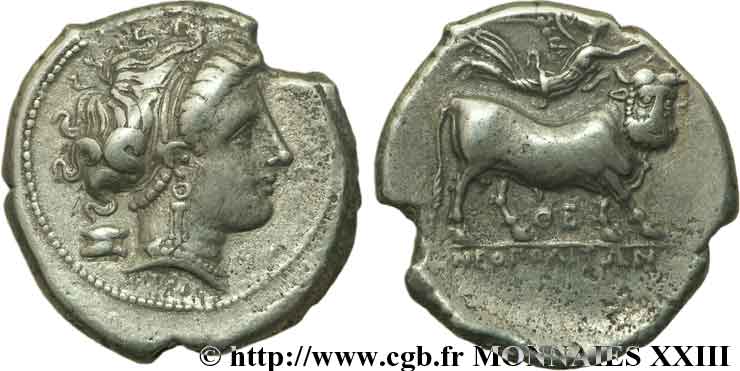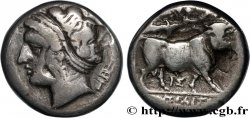v23_0002 - CAMPANIA - NEAPOLIS Nomos ou didrachme
MONNAIES 23 (2004)
Начальная цена : 200.00 €
Назначить цену : 350.00 €
Цена реализации : 200.00 €
Количество ставок : 1
Максимальная предлагаемая цена : 200.00 €
Начальная цена : 200.00 €
Назначить цену : 350.00 €
Цена реализации : 200.00 €
Количество ставок : 1
Максимальная предлагаемая цена : 200.00 €
Тип Nomos ou didrachme
Дата: c. 326/317-290 AC.
Монетный двор / Город: Naples
Металл: silver
Диаметр: 22 mm
Ориентация осей монеты: 2 h.
Вес: 7,02 g.
Комментарии о состоянии
Flan très large, mais échancré à 1 heure. Beau portrait de style très fin, bien centré des deux côtés. Métal très légèrement piqué au revers à l’exergue
Ссылки в каталоге: :
Лицевая сторона
Аверс: описание: Tête de la nymphe Parthénopé ou Néapolis à droite, la chevelure bouclée, ceinte d’un bandeau avec collier et boucle d’oreille ; derrière la tête, un osselet.
Аверс: легенда: [ARTEMI]
Обратная сторона
Реверс: Описание: Taureau androcéphale passant à droite, la tête barbue de face, couronné par Niké volant à droite ; entre les pattes, deux lettres.
Реверс: легенда: NEOPOLITW[N]/ QE
Комментарий
Poids léger. Pour ce type, A. Sambon signalait déjà en 1903 que le nom au droit sous la tête de la nymphe doit être restitué sous la forme (Artemion ou plutôt Artemidoros). Sur notre exemplaire, le nom sous la tête de la nymphe n’est pas lisible et semble gravé en creux. Le visage présente une attitude altière avec une chevelure très ornementée qui n’est pas sans rappeler les représentations syracusaines. C’est l’un des types les plus courants du monnayage napolitain. Au droit, derrière la tête de la nymphe, nous avons la représentation d’un osselet ou astragale qui servait dans des jeux de hasard et d’adresse. Les osselets étaient en os ou en bronze et sont souvent figurés dans l’art grec (cités par Pline l’Ancien dans son Histoire Naturelle, HN. XXIV, 19,2).
Light weight. For this type, A. Sambon already pointed out in 1903 that the name on the obverse under the nymph's head should be restored in the form (Artemion or rather Artemidoros). On our example, the name under the nymph's head is not legible and seems to be engraved in hollow. The face presents a haughty attitude with highly ornamented hair that is reminiscent of Syracusan representations. This is one of the most common types of Neapolitan coinage. On the obverse, behind the nymph's head, we have the representation of a knucklebone or astragalus that was used in games of chance and skill. Knucklebones were made of bone or bronze and are often depicted in Greek art (cited by Pliny the Elder in his Natural History, HN. XXIV, 19,2)
Light weight. For this type, A. Sambon already pointed out in 1903 that the name on the obverse under the nymph's head should be restored in the form (Artemion or rather Artemidoros). On our example, the name under the nymph's head is not legible and seems to be engraved in hollow. The face presents a haughty attitude with highly ornamented hair that is reminiscent of Syracusan representations. This is one of the most common types of Neapolitan coinage. On the obverse, behind the nymph's head, we have the representation of a knucklebone or astragalus that was used in games of chance and skill. Knucklebones were made of bone or bronze and are often depicted in Greek art (cited by Pliny the Elder in his Natural History, HN. XXIV, 19,2)








 Cообщить об ошибке
Cообщить об ошибке Распечатать страницу
Распечатать страницу Отправить мой выбор
Отправить мой выбор Задать вопрос
Задать вопрос Consign / sell
Consign / sell
 Информация
Информация










